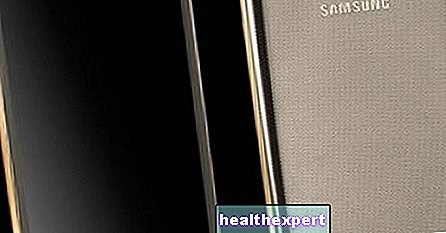Is it possible to eat squid when pregnant without risk?
The diet of a future mother is characterized by the quality of the raw materials and by some more care than what is put on the plate. In particular, there are some foods, which although delicious, must be set aside for the entire period of gestation, and sometimes until the end of breastfeeding. This serves to protect both the mother and the fetus. Find out in this video what these foods are.
Feeding in pregnancy
The 9 months of waiting are a special period for a woman, full of expectations but also of special attention. An important aspect that must certainly be changed from the beginning is the diet: the diet of a future mother is in fact more balanced and has some sacrifices, without having to undergo strict dietary regimes.
Some foods normally do not cause concern, but for those who are pregnant the question is different ... so then doubts arise. How to do? Today we try to clarify a possible uncertainty about the intake of one of the most popular seafood second courses, squid.
Before talking about this tasty food specifically, let's see what are the pros and cons of eating fish when pregnant.
See also




The benefits of eating fish when pregnant
Seafood and fish in general are among the most loved foods in Mediterranean cultures and it is not always clear whether a pregnant woman can take them safely.
Now, fish, even according to doctors, can be safely consumed even by those who are expecting a baby, because it brings many benefits to both the mother and the baby in the belly.
The friends of the sea are in fact rich in Omega-3, iodine, proteins and essential fats, all excellent nutrients to ensure a healthy diet during pregnancy.
Fatty acids are essential for the healthy development of the fetus, while iodine is a precious ally for the baby's cognitive growth. Finally, the stocks of iron, calcium and mineral salts improve the development of the nervous and cardiovascular systems.
Consuming fish in the right doses can even help the new mother in the fight against postpartum depression.
So, if you love fish, don't be afraid to eat it with taste! You can safely continue to add it to your diet, as long as you are careful about the harmful substances that some of the marine species may contain.

The most suitable fish for those expecting a baby
Now that we have discovered that not only eating fish when pregnant is allowed, but even recommended, we want to suggest some species that are particularly suitable for those who are pregnant.
When you are pregnant, the best fish to eat is the blue one: it is full of benefits and it is perhaps the marine animal family that contains the most Omega-3s. White fish is also a good choice at the table: although the values of fatty acids are lower than blue fish, white fish is still rich in nutrients and is decidedly lean.
Below you will find specifically which are the species of blue fish and white fish that you can eat safely during pregnancy.
Blue fish
- Sardinian, particularly rich in proteins, phosphorus, Omega 3 fatty acids, vitamin PP, potassium and magnesium;
- herring;
- anchovy or anchovy, rich in iron, iodine and essential minerals
- mackerel.
White fish
- sea bream, very lean and rich in omega-3s;
- sea bass or sea bass, which helps lower cholesterol levels;
- sole, also loved by newborns, so much so that it is included in their diet from 9 months of age.
All these species are low in calories, easy to digest and very light!

Which fish and shellfish to avoid during pregnancy and why
The fish to be excluded during the months of gestation are the large species. The most common are tuna and swordfish, which can contain high doses of mercury, which is really harmful to our body and that of the fetus.
In fact, this metal compromises the child's future neurological and behavioral development.
On the other hand, for molluscs and other crustaceans, how should a pregnant woman regulate?
The squid, the protagonists of our article, are very tasty molluscs, healthy and really appetizing, which decorate the tables of half of Italy when it is in summer, especially at the sea.
But is it safe to eat some when pregnant?
Like other seafood products, squid is also a food that is killed immediately after being caught. The abatement involves a strong temperature range that causes the death of all pathogens that may be inside. Consequently, as regards its processing, nothing to say, even for those who are pregnant. This food should be , at least on the pathogenic level, a safe dish to eat.
The problem with squid is that it is often fished in polluted areas and therefore, just like large fish, it risks absorbing large quantities of mercury, the harmfulness of which we have just highlighted. Ingesting it could endanger the health of the baby.
Fortunately, if the squid is cooked properly and if its consumption is not excessive, these risks are drastically lowered and it is therefore a food that even expectant mothers can eat!

While pregnant, squid is eaten well cooked
Squid, but also all other fish and shellfish, can be eaten during pregnancy a couple of times a week, and only if well cooked. It is essential for a pregnant woman to follow this rule, in order to avoid the risk of infections such as salmonellosis, toxoplasmosis and listeriosis.
Salmonella does not pass the placental barrier, but, if contracted during pregnancy, it can be more dangerous because it would involve an "intake of extra drugs that when you are pregnant it is better to limit as much as possible."
Listeriosis, on the other hand, is a disease caused by a bacterium present in meat, fish, seafood and cheeses. Its bacterium is only killed if the food is cooked to at least 70 ° C. The same goes for toxoplasmosis. Any type of raw or undercooked shellfish should therefore be avoided: the risks are so many. Nothing raw even for other fish species.
If you are a pregnant mother, also check the origin of these sea foods and never eat them in abundance: clams, cockles, razor clams, scallops, oysters, sea snails, octopuses, squid, squid and cuttlefish.
Mussels should be avoided completely, while clams can only be eaten if well cooked; even after being frozen they must be cooked.

Pay attention to the different types of cooking
Eating cooked squid while pregnant provides vitamins and trace elements. The main nutrient is iodine which plays a very important role for our body: it allows the thyroid to function properly and promotes good brain development in the baby.
However, not all cooking is recommended for expectant mothers. Frying, for example, is to be avoided for a few months, until at least the baby is born.
We know that fried squid is a truly irresistible dish, but this cooking method is far too high in fat for those who are expecting a baby. Fried food absorbs oil and also has high amounts of salt.
It would therefore be wiser to avoid it, or at most rarely give it to oneself; instead prefer a nice grilled calamarata: healthy and light.
Another type of cooking not recommended during pregnancy is smoking, which is used when cooking salmon.
Salmon is a fish that can be eaten when pregnant because it contributes to the correct bone formation of the child and fights osteoporosis. However, it is not good if it is prepared using the smoking technique, because it is cold smoked, without cooking, and this increases the risk of contracting listeriosis due to the presence of the bacterium Listeria monocytogenes.
Another story if the salmon is fresh and well cooked, or marinated.
Finally, here are some easy and delicious recipes of squid or blue fish.

Recipe for baked anchovies accompanied by sautéed vegetables
This is one of the recipes recommended for pregnant women and their babies! A well balanced dish full of healthy nutrients.
Ingredients for 4 people
- 1 Kg of anchovies or mackerel to be cleaned
- 300 gr artichokes
- 300 gr carrots
- 1 clove of garlic
- a handful of parsley
- 1 tablespoon of fennel seeds
- 4 soup spoons of extra virgin olive oil
- 50 gr of chopped almonds with the cuticle
- juice of one lemon
- a sprinkle of dried celery
- a pinch of salt
Preparation
First it is better to take care of the vegetables. Start by cleaning the artichokes from the outer leaves, cutting them in half and removing the fluff inside. Then they will be cut into thin strips to put them in water, with lemon and ice to prevent them from blackening.
Clean the carrots and cut them into small pieces; in a pan, stew the garlic with 1 tablespoon of olive oil and a drop of water for a couple of minutes. Add the vegetables with the chopped parsley and a full glass of water. Season with salt.
At this point it is possible to close the pot with the lid and let the vegetables cook over low heat for 20 minutes.
If at the end of cooking you notice excess water, raise the heat and let it cook for another 5 minutes without a lid. Meanwhile, preheat the static oven to 180 ° and place the parchment paper on a cutter.
Now chop the almonds, to add them to the powdered celery.
At this point it is time to work our blue fish: massage the anchovy or mackerel fillets with your hands sprinkled with oil. Pass them in the prepared breadcrumbs and place them in a pan. In the oven it will only take 7 or 8 minutes of cooking.
Finally, take the fillets out of the oven and serve them with the vegetables, if you prefer you can garnish the dish with fennel seeds and a few drops of lemon.

Recipe for fish skewers with Giallozafferano squid
Some recipes already taste of the sea and summer, like this recipe for squid skewers found on Giallozafferano. Easy and fast, it is typical of the Mediterranean diet. For future mothers always in a hurry!
Tip: The fish skewers will have a better effect if we add a little lemon to them, the iron contained in the ingredients will also be more absorbed.
Ingredients for 4 skewers
- Squid (4 of 250 g l "one, to be cleaned) 1 kg
- Dried tomatoes in oil 90 g
- Breadcrumbs 50 g
- Parsley to chop 1 tuft
- Lemon zest 1
- Laurel 4 leaves
- White pepper to taste
- Salt up to taste
- Extra virgin olive oil to taste
Preparation
First clean the squid, removing the head, skin, cartilage pen and eyes.
Once the operation is over, your squid will have to weigh about 550gr.
Pour the breadcrumbs into a bowl and add the grated lemon zest, chopped parsley, salt and white pepper. Mix everything by mixing well.
Return to the squid and stuff them with 2 teaspoons of the breadcrumbs mixture, 2 teaspoons of chopped dried tomatoes and a bay leaf, to be removed when eating the dish.
The tentacles that you had set aside during cleaning are to be put back at the end of the squid; skewer both the tentacles and the mantle with a long skewer toothpick, so as to hold it in place.
Spread the breadcrumb mixture on both sides of the squid, placing them on a cutting board to facilitate the operation.
Cook the fish over medium-low heat; once the pot is hot, place the squid over a drizzle of olive oil and let them go for 4-5 minutes. Turn them and cut them on the surface to help cooking. In total, the stuffed squid should be cooked for about 15 minutes.
To give the final touch you can prepare a citronette with lemon juice and extra virgin olive oil in a bowl, emulsifying it with a fork. When the squid are ready, transfer the skewers to the serving dish on top of a bed of lettuce. Sprinkle with your citronette. Enjoy your meal!
![]()



